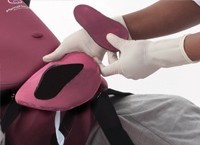MamaNatalie Birth Simulator

Problem being addressed[edit | edit source]
While preventative measures and treatment for postpartum hemorrhage do exist, high mortality rates still exist, often due to improper preparation and knowledge by the healthcare providers.
Detailed description of the solution[edit | edit source]
This is a low-tech birthing simulator. It is intended to be an educational tool for midwives to practice treating postpartum hemorrhage. The device is strapped to the instructor, who is able to control the fetal heart sounds, delivery of the placenta, baby position, uterine firmness, and volume and rate of blood flow loss.
Designed by[edit | edit source]
This device was invented by Laerdal, a clinical simulator product company. Laerdal has a wide network of distribution partners around the world.
- Manufacturer location:
Laerdal has manufacturing sites in the USA, Norway and China.
When and where it was tested/implemented[edit | edit source]
For every product bought for use in a developed country, Laerdal will donate one for use in training program in a developing country. It is being made available for $100 on a not-for-profit basis. They have performed field testing in Ethiopia, Tanzania, and India.
Funding Source[edit | edit source]
Private
References[edit | edit source]
Peer-reviewed publication[edit | edit source]
Crofts JF, Winter C, and Sowter MC. 2011. Practical simulation training for maternity care – where we are and where next. BJOG 118(Supp):11-16.
Abstract available here.
Other internally generated reports[edit | edit source]
Laerdal brochure.
Externally generated reports[edit | edit source]
Brown D. Low-tech pregnancy device might help birth attendants reduce maternal mortality Washington Post: 6 Jul 2010 accessed 9 Nov 2011.
IP and copyright[edit | edit source]
Laerdal Medical: WIPO 1035786, as of February 2010.